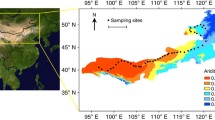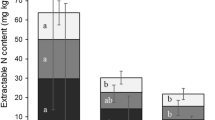Abstract
Increases in aridity forecasted by the end of this century will decouple the cycles of soil carbon (C), nitrogen (N) and phosphorus (P) in drylands—the largest terrestrial biome on Earth. Little is known, however, about how changes in aridity simultaneously affect the C:N:P stoichiometry of organisms across multiple trophic levels. It is imperative that we understand how aridity affects ecological stoichiometry so that we can develop strategies to mitigate any effects of changing climates. We characterized the C, N, P concentration and stoichiometry of soils, autotrophs (trees, N-fixing shrubs, grasses and mosses) and heterotrophs (microbes and ants) across a wide aridity gradient in Australia. Our results suggest that increases in aridity by the end of this century may alter the C:N:P stoichiometry of heterotrophs (ants and microbes), non-woody plants and in soil, but will not affect that one from woody plants. In particular, increases in aridity were positively related to C:P and N:P ratios in microbes and ants, negatively related to concentration of C, and the C:N and C:P ratios in mosses and/or short grasses, and not related to the C:N:P stoichiometry of either shrubs or trees. Because of the predominant role of C:N:P stoichiometry in driving nutrient cycling, our findings provide useful contextual information to determine ecological responses in a drier world.



Similar content being viewed by others
References
Anderson JM, Ingram JSI. 1993. Tropical soil biology and fertility. A handbook of methods. Wallingford: CABI.
Brookshire ENJ, Weaver T. 2016. Long-term decline in grassland productivity driven by increasing dryness. Nat Commun 6:7148.
Carnicer J, Sardans J, Stefanescu C, Ubach A, Bartrons M, Asensio D, Peñuelas J. 2015. Global biodiversity, stoichiometry and ecosystem function responses to human-induced C–N–P imbalances. J Plant Physiol 172:82–91.
Cease AJ, Elser JJ, Ford CF, Hao S, Kang L, Harrison JF. 2012. Heavy livestock grazing promotes locust outbreaks by lowering plant nitrogen concentration. Science 335:467–9.
Cease AJ, Elser JJ. 2013. Biological stoichiometry. nature education knowledge 4:15.
Chapin FSIII. 1980. The mineral nutrition of wild plants. Annu Rev Ecol Syst 11:233–60.
Clarke KR. 1993. Non-parametric multivariate analysis of changes in community structure. Austral J Ecol 18:117–43.
Csonka LN. 1989. Physiological and genetic responses of bacteria to osmotic stress. Microbiol Rev 53:121–47.
Delgado-Baquerizo M, Maestre FT, Gallardo A, Bowker MA, Wallenstein MD, Quero JL, Ochoa V, Gozalo B, García-Gómez M, Soliveres S et al. 2013. Decoupling of soil nutrient cycles as a function of aridity in global drylands. Nature 504:667–72.
Delgado-Baquerizo M, Maestre FT, Eldridge DJ, Singh BK. 2016a. Microsite differentiation drives the abundance of soil ammonia oxidizing bacteria along aridity gradients. Front Microbiol 7:505.
Delgado-Baquerizo M, Reich PB, García-Palacios P, Milla R. 2016b. Biogeographic bases for a shift in crop C:N:P stoichiometries during domestication. Ecol Lett 19:564–75.
Dijkstra FA, Augustine DJ, Brewer P, von Fischer JC. 2012. Nitrogen cycling and water pulses in semiarid grasslands: are microbial and plant processes temporally asynchronous? Oecologia 170:799–808.
Elser JJ, Sterner RW, Gorokhova E, Fagan WF, Markow TA, Cotner JB et al. 2000. Biological stoichiometry from genes to ecosystems. Ecol Lett 3:540–50.
Evans RD, Koyama A, Sonderegger DL, Charlet TN, Newingham BA, Fenstermaker LF, Harlow B, Jin VL, Ogle K, Smith SD, Nowak RS. 2014. Greater ecosystem carbon in the Mojave Desert after ten years exposure to elevated CO2. Nat Clim Change 4:394–7.
Feng S, Fu Q. 2013. Expansion of global drylands under a warming climate. Atmos Chem Phys 13:10081–94.
Frenette-Dussault C, Shipley B, Hingrat Y. 2013. Linking plant and insect traits to understand multitrophic community structure in arid steppes. Funct Ecol 27:786–92.
García-Palacios P, Maestre FT, Kattge J, Wall DH. 2013. Climate and litter quality differently modulate the effects of soil fauna on litter decomposition across biomes. Ecol Lett 16:1045–53.
Gibbs AG, Chippindale AK, Rose MR. 1997. Physiological mechanisms of evolved desiccation resistance in Drosophila melanogaster. J Exp Biol 200:1821–32.
He M, Zhang K, Tan H, Hu R, Su J, Wang J, Huang L, Zhang Y, Li X. 2015. Nutrient levels within leaves, stems, and roots of the xeric species Reaumuria soongorica in relation to geographical, climatic, and soil conditions. Ecol Evol 5:1494–503.
Huang J, Yu H, Guan X, Wang G, Guo R. 2016. Accelerated dryland expansion under climate change. Nat Clim Change 6:166–71.
Jiao F, Shi X-R, Han F-P, Yuan Z-Y. 2016. Increasing aridity, temperature and soil pH induce soil C–N–P imbalance in grasslands. Sci Rep 6:19601.
Jones DL, Willett VB. 2006. Experimental evaluation of methods to quantify dissolved organic nitrogen DON and dissolved organic carbon DOC in soil. Soil Biol Biochem 38:991–9.
Maestre FT, Delgado-Baquerizo M, Jeffries TC, Eldridge DJ, Ochoa V, Gozalo B, Quero JL, García-Gómez M, Gallardo A, Ulrich W, Bowker MA, Arredondo T et al. 2015. Increasing aridity reduces soil microbial diversity and abundance in global drylands. Proc Natl Acad Sci USA 112:15684–9.
Mazzacavallo MG, Kulmatiski A. 2015. Modelling water uptake provides a new perspective on grass and tree coexistence. PLoS ONE 10:e0144300.
Nakagawa S, Cuthill IC. 2007. Effect size, confidence interval and statistical significance: a practical guide for biologists. Biol Rev 82:591–605.
Näsholm T, Ekblad A, Nordin A, Giesler R, Högberg M, Högberg P. 1998. Boreal forest plants take up organic nitrogen. Nature 392:914–16.
Olsen S, Cole C, Watanabe F, Dean L. 1954. Estimation of available phosphorus in soils by extraction with sodium bicarbonate. Washington: USDA Circular Nr 939, US Government Printing Office.
Pan Z, Pitt WG, Zhang Y, Wu N, Tao Y, Truscott TT. 2016. The upside-down water collection system of Syntrichia caninervis. Nat Plants 2:16076.
Peñuelas J, Sardans J. 2009. Elementary factors. Nature 460:803–4.
Prăvălie R. 2016. Drylands extent and environmental issues. A global approach. Earth Sci Rev 161:259–78.
Rabbi SM, Tighe M, Delgado-Baquerizo M, Cowie A, Robertson F, Dalal R, Page K, Crawford D, Wilson BR, Schwenke G, Mcleod M, Badgery W, Dang YP, Bell M, O’Leary G, de Liu, L, Baldock J. 2015. Climate and soil properties limit the positive effects of land use reversion on carbon storage in Eastern Australia. Sci Rep 5:17866.
Reich PB. 2014. The world-wide ‘fast–slow’ plant economics spectrum: a traits manifesto. J Ecol 102:275–301.
Rosenberg, Adams DC, Gurevitch J. 2000. MetaWin 2.0: statistical software for meta-analysis. Sunderland: Sinauer Assoc.
Sardans J, Rivas-Ubach A, Peñuelas J. 2012. The elemental stoichiometry of aquatic and terrestrial ecosystems and its relationships with organismic lifestyle and ecosystem structure and function: a review and perspectives. Biogeochemistry 111:1–39.
Shewmaker GE, Mayland HF, Rosenau RC, Asay KH. 1989. Silicon in C-3 grasses: effects on forage quality and sheep preference. J Range Manag 42:122–7.
Schimel J, Balser TC, Wallenstein M. 2007. Microbial stress-response physiology and its implications for ecosystem function. Ecology 88:1386–94.
Tiessen H, Moir JO. 1993. Characterization of available P by sequential fractionation. Soil sampling and methods of analysis. Boca Raton: Lewis Publishers.
United Nations Environment Programme. 1992. World atlas of desertification UNEP. London: Edward Arnold.
Voroney RP, Brookes PC, Beyaert RP. 2006. Soil microbial biomass C, N, P, and S. In: Carter MR, Gregorich EG, Eds. Soil sampling and methods of analysis. Boca Raton: Lewis.
Wang C, Wang X, Liu D, Wu H, Lü X, Fang Y, Cheng W, Luo W, Jiang P, Shi J, Yin H, Zhou J, Han X, Bai E. 2014. Aridity threshold in controlling ecosystem nitrogen cycling in arid and semi-arid grasslands. Nat Commun 5:4799.
Walter H. 1939. Grasland, Savanne und Busch der arideren Teile Afrikas in ihrer ökologischen Bedingtheit. Jahrb Wiss Bot 87:750–860.
Ward D, Wiegand K, Getzin S. 2013. Walter’s two-layer hypothesis revisited: back to the roots!. Oecologia 172:617–30.
Weldon CW, Boardman L, Marlin D, Terblanche JS. 2016. Physiological mechanisms of dehydration tolerance contribute to the invasion potential of Ceratitis capitata Wiedemann Diptera: Tephritidae relative to its less widely distributed congeners. Front Zool 13:15.
Whitford WG. 1978. Foraging in seed-harvester ants Pogonomyrmex spp. Ecology 59:185–9.
Yuan ZY, Chen HYH. 2015. Decoupling of nitrogen and phosphorus in terrestrial plants associated with global changes. Nat Clim Change 5:465–9.
Zechmeister-Boltenstern S, Keiblinger KM, Mooshammer M, Peñuelas J, Richter A, Sardans J et al. 2015. The application of ecological stoichiometry to plant–microbial–soil organic matter transformations. Ecol Monogr 85:133–55.
Zomer RJ, Trabucco A, Bossio DA, van Straaten O, Verchot LV. 2008. Climate change mitigation: a spatial analysis of global land suitability for clean development mechanism afforestation and reforestation. Agric Ecosyst Environ 126:67–80.
Zornoza R, Guerrero C, Mataix-Solera J, Arcenegui V, García-Orenes F, Mataix- Beneyto J. 2006. Assessing air-drying and rewetting pre-treatment effect on some soil enzyme activities under Mediterranean conditions. Soil Biol Biochem 38:2125–34.
Zornoza R, Mataix-Solera J, Guerrero C, Arcenegui V, Mataix-Beneyto J. 2009. Storage effects on biochemical properties of air-dried soil samples from southeastern Spain. Arid Land Restaur Manag 23:213–22.
Acknowledgements
This study was supported by the Australian Research Council (Project DP13010484; DP170104634), by GRDC (UWS00008) and by the European Research Council (ERC) under the European Community’s Seventh Framework Programme (FP7/2007-2013)/ERC Grant Agreement No. 242658 (BIOCOM). M.D-B. also acknowledges support from the Marie Sklodowska-Curie Actions of the Horizon 2020 Framework Programme H2020-MSCA-IF-2016 under REA Grant Agreement No. 702057. DJE was supported by the Hermon Slade Foundation. FTM acknowledges support from the European Research Council (BIODESERT Project, ERC Grant Agreement No. 647038) and by the Spanish Ministry of Economy and Competitiveness (BIOMOD Project, CGL2013-44661-R).
Data Accessibility
Data associated with this paper have been deposited in figshare: https://figshare.com/s/d736cb67a3397d3c7f1c (10.6084/m9.figshare.5056486).
Author information
Authors and Affiliations
Corresponding author
Electronic supplementary material
Below is the link to the electronic supplementary material.
Rights and permissions
About this article
Cite this article
Delgado-Baquerizo, M., Eldridge, D.J., Maestre, F.T. et al. Aridity Decouples C:N:P Stoichiometry Across Multiple Trophic Levels in Terrestrial Ecosystems. Ecosystems 21, 459–468 (2018). https://doi.org/10.1007/s10021-017-0161-9
Received:
Accepted:
Published:
Issue Date:
DOI: https://doi.org/10.1007/s10021-017-0161-9




